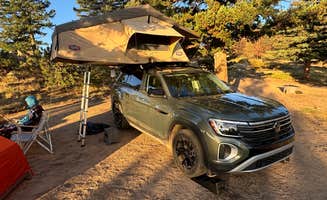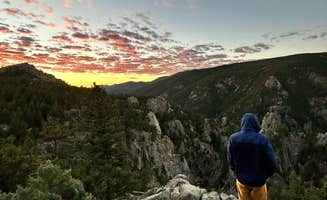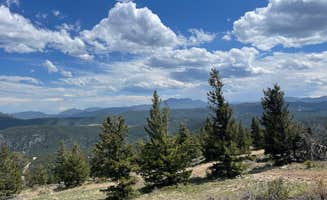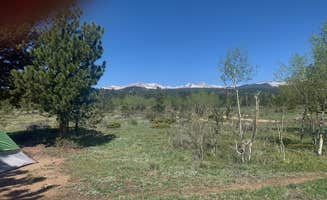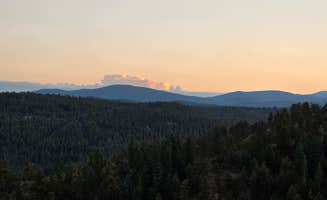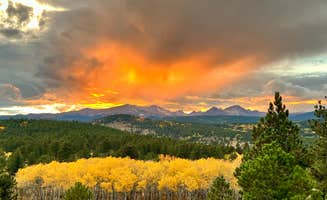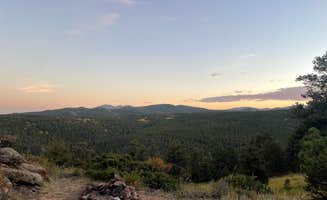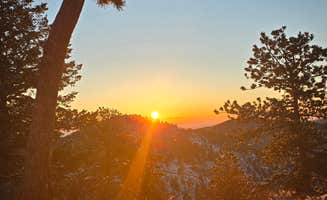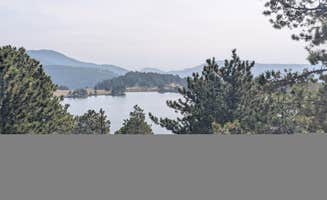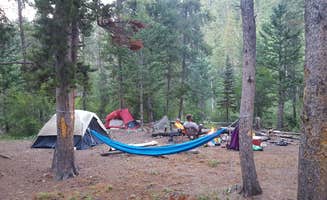Dispersed camping options near Northglenn, Colorado span elevations between 8,500-11,500 feet within the Roosevelt and Arapaho National Forests. These primitive sites offer no amenities but provide isolation from urban areas with temperatures that drop significantly after sunset even during summer months. Seasonal closures affect many access roads from late October through May due to snowpack conditions.
What to do
Wildlife viewing opportunities: At Beaver Park Reservoir Dispersed, campers frequently encounter diverse wildlife. "Long dirt road, with many spots to pick from along it. Road was bumpy but most cars could manage. Lots of wildlife; squirrels, rabbits, and a moose that walked right by our campsite," reports Benjamin G.
Mountain biking access: The West Magnolia Campground offers extensive trail networks. "Great spot for mountain biking, hiking, and camping," according to Briley M. Another camper adds, "Beautiful spot; close enough to civilization to feel secure yet secluded enough to feel private."
Creek fishing opportunities: Several sites feature stream access for recreational fishing. At Allenspark Dispersed Camping, campers can enjoy water features as mentioned by Danielle S.: "Right next to a creek, nice to have a water feature." Most creeks in the area contain native brook and brown trout but require a Colorado fishing license.
Rock climbing proximity: Some rustic camping near Northglenn provides access to climbing routes. "Lots of climbing routes nearby and easy to find some good spots away from others," notes Hayley K. about the primitive camping areas. Most climbing areas require a 20-30 minute hike from established campsites.
What campers like
Aspen forests: The rustic camping experience includes scenic aspen groves. One camper at N Boulder Creek Dispersed Camping shared: "There are mountains and aspen forests and wildflowers everywhere! I also saw elk nearby." Aspens typically change color between mid-September and early October.
Stargazing opportunities: Clear mountain skies provide excellent night viewing. Steph P. noted about Forest Road 332 Dispersed: "There's city glow from Boulder but still dark enough to see plenty of stars to the southwest." Most sites above 9,000 feet elevation offer reduced light pollution.
Seasonal wildflowers: Summer months bring abundant wildflowers to camping areas. "Lots of chipmunks and hummingbirds due to the many wild flowers," reports Dian G. when camping in the area. Peak wildflower season typically runs mid-June through early August depending on elevation.
Water features: Many campsites include stream or lake views. As noted by Brett A.: "It was gorgeous! Lots of spots, and also lots of people. Some folks coming in late night. It's definitely a bumpy ride in." Creek-side sites typically fill first due to their popularity.
What you should know
Vehicle requirements vary: Access roads to many sites deteriorate significantly after rain. "Road gets tougher the further back you go, but my low clearance vehicle made it by driving slow," explains a camper at Gordon Gulch Dispersed Area. Most access roads become increasingly challenging after the first mile.
Wildlife precautions necessary: Bear activity requires proper food storage. "The second day staying there we ran into a bear and scared him off. Two hours later he came back and we scared him off again. He's afraid of humans but he did try to get into the car while we were sleeping," warns Ben O.
Weather fluctuations: Mountain weather changes rapidly regardless of season. "It was a super windy night. Popular spot," reports Brett A. about overnight conditions. Temperature drops of 30-40 degrees between day and night occur regularly.
Weekend crowding: Sites fill quickly Friday through Sunday. "Being towards the end we saw very few people and it was quite and serene," notes Sue B. about her weekday experience, contrasting with weekend patterns where most sites fill by noon on Fridays.
Tips for camping with families
Kid-friendly hiking options: Several shorter trails accommodate younger children. A camper describes: "There is a super easy family-friendly mini hike with great view and a little cell access. If you are facing the lake, to your right just behind you there are some rocks. Walk toward them and then maybe 30 yards away from the lake you can walk right up. Just follow your way up that hill to a rocky outlook. 15 minutes if you have a small child 5 minutes if you are young and able to the top."
Privacy considerations: Select sites further from main roads. "We had the dispersed camping areas almost all to ourself. There are plenty of flat spots to set up, close to the parking area or a bit of a trek through the woods," explains Sierra T. Sites located on spurs off main forest roads typically offer more seclusion.
Cell service limitations: Most camping areas have minimal connectivity. "I also was able to get some service with Verizon periodically. Was able to send some texts but no pictures," reports James S. Emergency communications may require traveling to higher elevations or back toward towns.
Bug protection essential: Insects can be problematic in warmer months. "Definitely bring bug spray as the flies and mosquitoes were thirsty," advises a camper named Jess. Most insect activity peaks during July and August, particularly near water sources.
Tips from RVers
Site size limitations: Many dispersed sites accommodate smaller RVs only. "Beautiful lake with several good sized RV spots. We have a 25 foot camper and feet nicely in. Road in was good as well (May 2025)," notes James S. at Dream Canyon Campsites. Most accessible sites have a maximum length limitation of 25-28 feet.
Leveling challenges: Prepare for uneven terrain at most sites. "Not all campgrounds are really that flat but it's free and it's Boulder, CO environment so I can't complain," explains Elisha E. Bringing adequate leveling blocks is essential for most rustic camping areas near Northglenn.
Road condition monitoring: Road conditions change seasonally and after precipitation. "They plow the main dirt road which makes the campsites difficult to get into because the snow banks block them, getting into the site was the hardest part of the drive," reports Catalina H. about winter access. Forest service roads receive minimal maintenance outside of emergency repairs.
Turnaround limitations: Some roads lack adequate turning space for larger vehicles. "Be forewarned, the private land area at the end of the road does not have any turn around space," warns Brian M. Always scout ahead before taking larger vehicles down unfamiliar forest roads.


